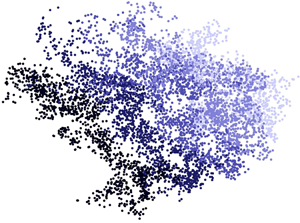Article contents
Life and death of inertial particle clusters in turbulence
Published online by Cambridge University Press: 14 September 2020
Abstract

Clusters of inertial particles in turbulence are usually identified from the spatial coherence of the particle concentration field, neglecting their temporal persistence. The latter is in fact essential to the ability of the particles to interact with each other and to modify the flow. Here, we leverage simulations of homogeneous isotropic turbulence laden with small heavy particles and develop a Lagrangian framework to follow them before, during and after their time as part of a coherent cluster. We define a criterion to establish whether a cluster survives over successive time steps, and use it to characterize its lifetime. We find that cluster lives have typical durations of a few Kolmogorov time scales, with positive correlation between cluster size and lifetime. Increasing inertia and gravitational settling both lead to longer lifetimes. Small clusters emerge from the coagulation of non-clustered particles, quickly followed by disintegration into prevalently non-clustered particles. By contrast, large clusters result from the recombination of other large clusters. The birth of a cluster is preceded by an exponential contraction of the particle cloud, and its death coincides with the beginning of a slower exponential expansion, The contraction is simultaneous to a decline in the local small-scale turbulence activity, while the expansion is accompanied by its recovery. Therefore, during their lifetime, the clusters experience lower-than-average enstrophy and strain rate in the fluid. This relatively quiescent state of the flow is thus a necessary condition for the cluster survival, at least in the considered range of turbulence intensity and particle inertia.
JFM classification
- Type
- JFM Rapids
- Information
- Copyright
- © The Author(s), 2020. Published by Cambridge University Press
Footnotes
Present address: Department of Mechanical and Process Engineering, ETH Zurich, Switzerland.
References
REFERENCES
- 27
- Cited by



